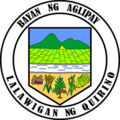Aglipay | |
|---|---|
| Municipality of Aglipay | |
 Map of Quirino with Aglipay highlighted | |
Location within the Philippines | |
| Coordinates: 16°29′20″N121°35′14″E / 16.488875°N 121.58735°E | |
| Country | Philippines |
| Region | Cagayan Valley |
| Province | Quirino |
| District | Lone district |
| Named after | Gregorio Aglipay |
| Barangays | 25 (see Barangays) |
| Government | |
| • Type | Sangguniang Bayan |
| • Mayor | Jerry T. Agsalda |
| • Vice Mayor | Warlita G. Alberto |
| • Representative | Junie E. Cua |
| • Municipal Council | Members |
| • Electorate | 19,431 voters (2025) |
| Area | |
• Total | 161.70 km2 (62.43 sq mi) |
| Elevation | 146 m (479 ft) |
| Highest elevation | 477 m (1,565 ft) |
| Lowest elevation | 95 m (312 ft) |
| Population (2024 census) [3] | |
• Total | 31,596 |
| • Density | 195.40/km2 (506.08/sq mi) |
| • Households | 7,740 |
| Economy | |
| • Income class | 3rd municipal income class |
| • Poverty incidence | 11.58 |
| • Revenue | ₱ 221.2 million (2022) |
| • Assets | ₱ 278.9 million (2022) |
| • Expenditure | ₱ 178.2 million (2022) |
| • Liabilities | ₱ 43.45 million (2022) |
| Service provider | |
| • Electricity | Quirino Electric Cooperative (QUIRELCO) |
| Time zone | UTC+8 (PST) |
| ZIP code | 3403 |
| PSGC | |
| IDD : area code | +63 (0)78 |
| Native languages | Ilocano Bugkalot Arta Tagalog |
| Website | www |
Aglipay, officially the Municipality of Aglipay (Ilocano : Ili ti Aglipay; Tagalog : Bayan ng Aglipay), is a municipality in the province of Quirino, Philippines. According to the 2024 census, it has a population of 31,596 people. [5]



